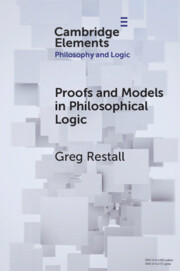14 results
COLLECTION FRAMES FOR DISTRIBUTIVE SUBSTRUCTURAL LOGICS
- Part of
-
- Journal:
- The Review of Symbolic Logic / Volume 16 / Issue 4 / December 2023
- Published online by Cambridge University Press:
- 13 July 2022, pp. 1120-1157
- Print publication:
- December 2023
-
- Article
-
- You have access
- Open access
- HTML
- Export citation
Jc Beall, The Contradictory Christ (Oxford: Oxford University Press, 2021. Pp. xvii + 185. £45.00 (Hbk). ISBN 9780199952360.
-
- Journal:
- Religious Studies / Volume 59 / Issue 3 / September 2023
- Published online by Cambridge University Press:
- 07 June 2022, pp. 556-559
- Print publication:
- September 2023
-
- Article
- Export citation

Proofs and Models in Philosophical Logic
-
- Published online:
- 25 March 2022
- Print publication:
- 21 April 2022
-
- Element
- Export citation
GENERALITY AND EXISTENCE 1: QUANTIFICATION AND FREE LOGIC
-
- Journal:
- The Review of Symbolic Logic / Volume 12 / Issue 1 / March 2019
- Published online by Cambridge University Press:
- 18 December 2018, pp. 1-29
- Print publication:
- March 2019
-
- Article
- Export citation
Decorated linear order types and the theory of concatenation
-
-
- Book:
- Logic Colloquium 2007
- Published online:
- 01 March 2011
- Print publication:
- 07 June 2010, pp 1-13
-
- Chapter
- Export citation
Proof theory and meaning: On the context of deducibility
-
-
- Book:
- Logic Colloquium 2007
- Published online:
- 01 March 2011
- Print publication:
- 07 June 2010, pp 204-219
-
- Chapter
- Export citation
4 - Truth-makers, entailment and necessity
- from Part I - Setting the stage
-
-
- Book:
- Truth and Truth-Making
- Published by:
- Acumen Publishing
- Published online:
- 05 February 2013
- Print publication:
- 05 December 2008, pp 87-97
-
- Chapter
- Export citation
5 - Postscript to “Truth-makers, entailment and necessity”
- from Part I - Setting the stage
-
-
- Book:
- Truth and Truth-Making
- Published by:
- Acumen Publishing
- Published online:
- 05 February 2013
- Print publication:
- 05 December 2008, pp 98-101
-
- Chapter
- Export citation
The 2007 Annual Conference of the Australasian Association for Logic
-
- Journal:
- Bulletin of Symbolic Logic / Volume 14 / Issue 3 / September 2008
- Published online by Cambridge University Press:
- 15 January 2014, pp. 438-443
- Print publication:
- September 2008
-
- Article
- Export citation
MODAL MODELS FOR BRADWARDINE'S THEORY OF TRUTH
-
- Journal:
- The Review of Symbolic Logic / Volume 1 / Issue 2 / August 2008
- Published online by Cambridge University Press:
- 01 August 2008, pp. 225-240
- Print publication:
- August 2008
-
- Article
- Export citation
Proofnets for S5: Sequents and circuits for modal logic
-
-
- Book:
- Logic Colloquium 2005
- Published online:
- 18 December 2009
- Print publication:
- 03 December 2007, pp 151-172
-
- Chapter
- Export citation
Ross Brady. Universal logic. CSLI Lecture Notes, vol. 109. CSLI Publications, Stanford, 2006, xii + 346 pp.
-
- Journal:
- Bulletin of Symbolic Logic / Volume 13 / Issue 4 / December 2007
- Published online by Cambridge University Press:
- 15 January 2014, pp. 544-547
- Print publication:
- December 2007
-
- Article
- Export citation
The geometry of non-distributive logics
-
- Journal:
- The Journal of Symbolic Logic / Volume 70 / Issue 4 / December 2005
- Published online by Cambridge University Press:
- 12 March 2014, pp. 1108-1126
- Print publication:
- December 2005
-
- Article
- Export citation
Australasian Association for Logic 29th Annual Conference
-
- Journal:
- Bulletin of Symbolic Logic / Volume 5 / Issue 4 / December 1999
- Published online by Cambridge University Press:
- 15 January 2014, pp. 485-494
- Print publication:
- December 1999
-
- Article
- Export citation








